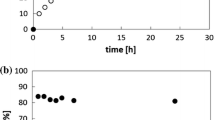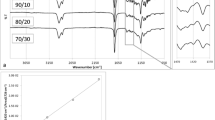Abstract
Biodegradable polymer networks were prepared by photo-initiated radical polymerization of methacrylate functionalized poly(d,l-lactide) oligomers. The kinetic chains formed in this radical polymerization are the multifunctional crosslinks of the networks. These chains are carbon–carbon chains that remain after degradation. If their molecular weight is too high these poly(methacrylic acid) chains can not be excreted by the kidneys. The effect of the photo-initiator concentration and the addition of 2-mercaptoethanol as a chain transfer agent on the molecular weight of the kinetic chains was investigated. It was found that both increasing the initiator concentration and adding 2-mercaptoethanol decrease the kinetic chain length. However, the effect of adding 2-mercaptoethanol was much larger. Some network properties such as the glass transition temperature and the swelling ratio in acetone are affected when the kinetic chain length is decreased.








Similar content being viewed by others
References
Melchels FPW, Feijen J, Grijpma DW. A review on stereolithography and its applications in biomedical engineering. Biomaterials. 2010;31:6121–30.
Bryant SJ, Anseth KS. Hydrogel properties influence ECM production by chondrocytes photoencapsulated in poly(ethylene glycol) hydrogels. J Biomed Mater Res. 2002;59:63–71.
Davis K. Controlled release from crosslinked degradable networks. Crit Rev Ther Drug Carr Syst. 2002;19:385–423.
Ifkovits JL, Burdick JA. Review: photopolymerizable and degradable biomaterials for tissue engineering applications. Tissue Eng. 2007;13:2369–85.
Grijpma DW, Hou Q, Feijen J. Preparation of biodegradable networks by photo-crosslinking lactide, ε-caprolactone and trimethylene carbonate-based oligomers functionalized with fumaric acid monoethyl ester. Biomaterials. 2005;26:2795–802.
Brenner BM, Hostetter TH, Humes HD. Glomularpermselectivity: barrier function based on discrimination of molecular-size and charge. Am J Physiol. 1978;234:F455–60.
Yamaoka T, Tabata Y, Ikada Y. Distribution and tissue uptake of poly(ethylene glycol) with different molecular weights after intravenous administration to mice. J Pharm Sci. 1994;83:601–6.
Yamaoka T, Tabata Y, Ikada Y. Comparision of body distribution of poly(vinyl alcohol) with other water-soluble polymers after intravenous administration. J Pharm Pharmacol. 1995;47:479–85.
Murakami Y, Tabata Y, Ikada Y. Effect of the molecular weight of water-soluble polymers on accumulation at an inflammatory site following intravenous injection. Drug Deliv. 1996;3:231–8.
Ross WM, Martens AC, Vanbekkum DW. Polymethacrylic acid: induction of lymphocytosis and tissue distribution. Cell Tissue Kinet. 1975;8:467–77.
Burdick JA, Lovestead TM, Anseth KS. Kinetic chain lengths in highly cross-linked networks formed by the photoinitiated polymerization of divinyl monomers: a gel permeation chromatography investigation. Biomacromolecules. 2003;4:149–56.
Burkoth AK, Anseth KS. MALDI-TOF characterization of highly cross-linked, degradable polymer networks. Macromolecules. 1999;32:1438–44.
Peters R, Litvinov VM, Steeman P, Dias AA, Mengerink Y, van Benthem R, de Koster CG, van der Wal S, Schoenmakers P. Characterisation of UV-cured acrylate networks by means of hydrolysis followed by aqueous size-exclusion combined with reversed-phase chromatography. J Chromatogr A. 2007;1156:111–23.
Ghaffar A, Verschuren PG, Geenevasen JAJ, Handels T, Berard J, Plum B, Dias AA, Schoenmakers PJ, van der Wal S. Fast in vitro hydrolytic degradation of polyester urethane acrylate biomaterials: structure elucidation, separation and quantification of degradation products. J Chromatogr A. 2011;1218:449–58.
Melchels FPW, Velders AH, Feijen J, Grijpma DW. Photo-cross-linked poly(dl-lactide)-based networks. Structural characterization by HR-MAS NMR spectroscopy and hydrolytic degradation behavior. Macromolecules. 2010;43:8570–9.
Andrzejewska E. Photopolymerization kinetics of multifunctional monomers. Prog Polym Sci. 2001;26:605–65.
Rydholm AE, Held NL, Bowman CN, Anseth KS. Gel permeation chromatography characterization of the chain length distributions in thiol-acrylate photopolymer networks. Macromolecules. 2006;39:7882–8.
Odian G. Principles of polymerization. Hoboken: Wiley; 2004.
Deneke SM. Current topics in cellular regulation. San Diego: Academic Press Inc; 2000.
Ellman GL. Tissue sulfhydryl groups. Arch Biochem Biophys. 1959;82:70.
Matsubara H, Hata S, Kondo Y, Ishida Y, Takigawa H, Ohtani H. Characterization of cross-linking structures in UV-cured acrylic ester resin by MALDI-MS combined with supercritical methanolysis. Anal Sci. 2006;22:1403–7.
Fox TG, Loshaek S. Influence of molecular weight and degree of crosslinking on the specific volume and glass temperature of polymers I. J Polym Sci. 1955;15:371–90.
Rydholm AE, Reddy SK, Anseth KS, Bowman CN. Controlling network structure in degradable thiol-acrylate biomaterials to tune mass loss behavior. Biomacromolecules. 2006;7:2827–36.
Reddy SK, Anseth KS, Bowman CN. Modeling of network degradation in mixed step-chain growth polymerizations. Polymer. 2005;46:4212–22.
Melchels FPW, Feijen J, Grijpma DW. A poly(d,l-lactide) resin for the preparation of tissue engineering scaffolds by stereolithography. Biomaterials. 2009;30:3801–9.
Bryant SJ, Nuttelman CR, Anseth KS. Cytocompatibility of UV and visible light photoinitiating systems on cultured NIH/3T3 fibroblasts in vitro. J Biomater Sci Polym E. 2000;11:439–57.
Williams CG, Malik AN, Kim TK, Manson PN, Elisseeff JH. Variable cytocompatibility of six cell lines with photoinitiators used for polymerizing hydrogels and cell encapsulation. Biomaterials. 2005;26:1211.
Acknowledgments
We acknowledge Tieme Stevens for performing the MALDI-TOF MS measurements. This work was financially supported by DSM.
Author information
Authors and Affiliations
Corresponding author
Rights and permissions
About this article
Cite this article
Jansen, J., Ghaffar, A., van der Horst, T.N.S. et al. Controlling the kinetic chain length of the crosslinks in photo-polymerized biodegradable networks. J Mater Sci: Mater Med 24, 877–888 (2013). https://doi.org/10.1007/s10856-013-4873-x
Received:
Accepted:
Published:
Issue Date:
DOI: https://doi.org/10.1007/s10856-013-4873-x




